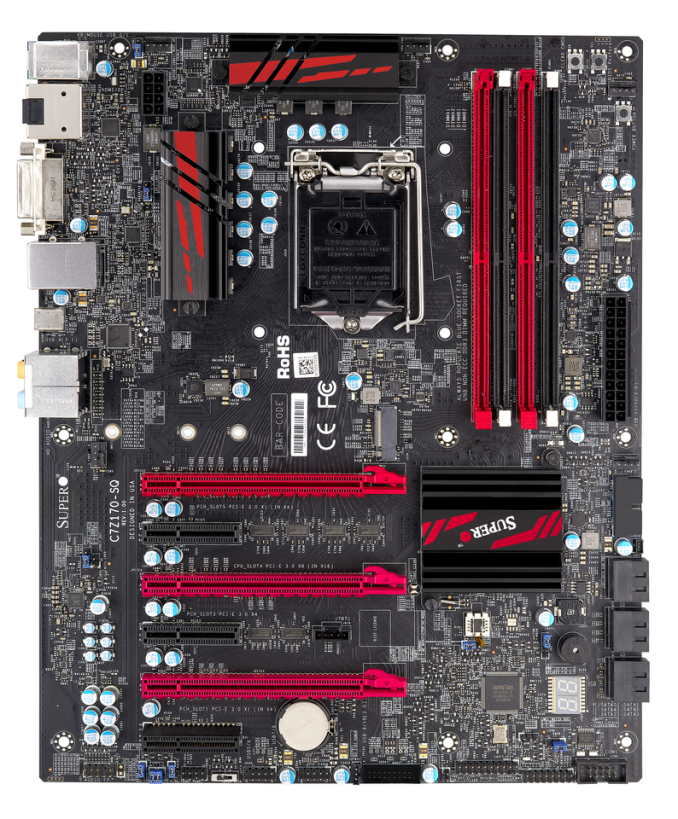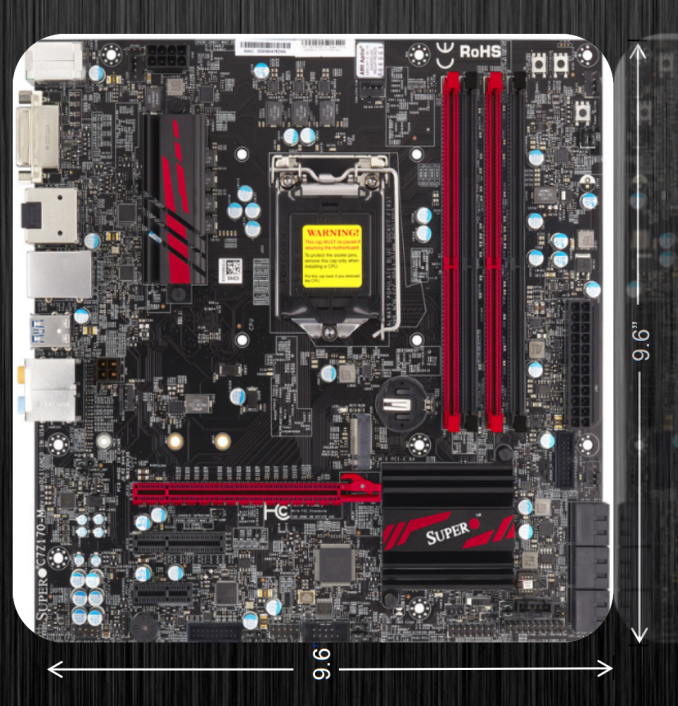Intel Skylake Z170 Motherboards: A Quick Look at 55+ New Products
by Ian Cutress on August 5, 2015 7:59 AM ESTSupermicro Z170
When you mention a consumer motherboard, the name Supermicro does not shout loud from the rooftops. Supermicro is more commonly associated in the server industry with a large chunk of market share for providing enterprise platforms that power a number of industries and government departments. Technically they have had consumer motherboard products now for a couple of years, sticking with a low number of models to test the waters. Supermicro relies more on the name of the brand and the engineer expertise in the server space to carry their product forward. For Z170, they have informed me that at this point two models are in the works although there are some final decisions to be made particularly about coloring and style, so the following pictures may not represent final product.
Supermicro C7Z170-SQ
The SQ is the ATX model, with Supermicro using the red and black color scheme of other Gaming lines to apply it to their own brand.
Here is what looks like a mid-range motherboard sporting an x8/x4/x4 PCIe 3.0 layout in red with x4/x1/x1 in the other black slots from the chipset. The PCIe layout is slightly different to other mainstream boards by virtue of the M.2 slot above them which operates in PCIe 3.0 x4 mode. Because of the arrangement, it means we have a sub-optimal PCIe card placement for dual GPU setups, whereby the top two red PCIe lanes are used which does not leave a ventilation gap which is usually important in a consumer design.
In terms of hardware support, we get six SATA ports, a single USB 3.1 Type-C port on the rear panel due to an ASMedia ASM1142 controller, an Intel I219-V network port and a Realtek ALC1150 audio solution. Unlike some other boards we get a couple of server features, such as TPM and SATA DOM, as well as all five fan headers on board being 4-pin. It will be interesting to see how Supermicro has developed its BIOS and software especially in light of the stiff competition of the regular consumer motherboard manufacturers in this area
Supermicro C7Z170-M
The M is for micro-ATX, and it looks like Supermicro is aiming at something more for the cost conscious user here:
For graphics there is a single PCIe 3.0 x16 slot and no second slot like other micro-ATX motherboards for a second card. Instead we get a fixed with PCIe 3.0 x4 slot and a PCIe x1 slot for good measure. Other functionality is similar to that of the full sized motherboard with six SATA ports, an Intel I219-V for network, a Realtek ALC1150 audio codec and an M.2 slot running in PCIe 3.0 x4 mode. Where the micro-ATX differs is in the power delivery heatsinks and this time the USB 3.1 capabilities have shifted from a single Type-C to two Type-A ports.
At this point pricing for these boards is unknown but a sample of the C7Z170-SQ just came in through the door. We will be testing it in due course.


















85 Comments
View All Comments
8steve8 - Wednesday, August 5, 2015 - link
how about the 6700k CPUs in the USA?Luminair - Wednesday, August 5, 2015 - link
FYI Asus has an alert on BBB for sending people broken products: http://www.bbb.org/greater-san-francisco/business-...Hundreds of complaints this year, including people with broken motherboard who did an RMA and received in return... a broken motherboard.
DanNeely - Wednesday, August 5, 2015 - link
Ugh. Are they only testing RMAs after getting them sent back twice? (Assuming the first time is user error, not a hardware fault?)apoclypse - Wednesday, August 5, 2015 - link
Wow. Remember when motherboards and computer components were ugly? Thos Asrock boards are a work of art. The same with the MSI boards. Not to impressed with what Asus has this time around (in-terms of looks). I've recently built a Haswell-E rig with the X99X from Asrock so I'm not really looking to buy anything but damn those boards make me regret not waiting. Ah well, I needed the extra cores anyway.NARC4457 - Wednesday, August 5, 2015 - link
Am I the only one that is still ridiculously confused at the next generation of fast storage? m.2/nvMe what's bootable, what's not, what pinout (B/M)....What the hell is going on with these standards (sic)?
Ian Cutress - Wednesday, August 5, 2015 - link
M.2 is a connection standard that can support both SATA and PCIe storage protocols. It is up to the manufacturer to decide which protocol to implement.SATA drives can use AHCI or IDE, while PCIe drives can be either AHCI or NVMe, but it depends on the controller if NVMe is supported.
Typically NVMe has to be enabled in the BIOS in order to boot from the drive, and you have to install the operating system in UEFI mode - basically Win8.1/10 does this already.
Most Z170 motherboards with M.2 PCIe 3.0 x4 should be supporting NVMe devices as boot drives , although I would still refer to the motherboard manufacturers website to confirm this is the case, either on the motherboard's page or in the motherboard's downloadable manual.
Hope that helps.
NARC4457 - Monday, August 10, 2015 - link
Thanks Ian, that actually helps a lot.joex4444 - Wednesday, August 5, 2015 - link
As an owner of a PCIe 2.0 x8 RAID card, I'd love to see someone put out a PCIe 3.0 x8 slot controlled by the PCH that's actually x8. I see a lot of slots that are physically x16, with x8 connectors but the text always refers to them as PCIe 3.0 x4 (PCH). As I've 8 drives connected to that, I want the full x8 connection. Now of course using the second physical x16 slot on SLI boards and taking 8 lanes from the CPU ought to work, but that drops the GPU down to an x8 link; it would be great to use x16/x8 instead of x16/x4 or x8/x8 here (GPU/RAID).Z170 looked so promising, but so far only X99 offers the PCIe configuration described above.
Ian Cutress - Wednesday, August 5, 2015 - link
The chipset essentially has five PCIe 3.0 x4 controllers, and you can't combine them into an x8. You could use a PCIe bridge chip like a PLX to convert 4 to 8, but you'll still be limited by the four lanes in into the chip. The only way you will get an 8-lane slot is from the processor, unfortunately (because then it would open up GPU possibilities).DanNeely - Wednesday, August 5, 2015 - link
Is there any reason other than market segmenting (protecting LGA2011's 40 CPU lanes) or avoiding a single device being able to max out the DMI link for them not to allow combos bigger than a 4x?